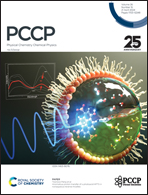A novel two-dimensional Janus TiSiGeN4 monolayer with N vacancies for efficient photocatalytic nitrogen reduction†
Abstract
The photocatalytic nitrogen reduction reaction (pNRR) is a clean technology that converts H2O and N2 into NH3 under environmental conditions using inexhaustible sunlight. Herein, we designed a novel two-dimensional (2D) Janus TiSiGeN4 structure and evaluated the pNRR performance of the structure with the presence of nitrogen vacancies at different positions using density functional theory (DFT) calculations. The intrinsic dipoles in the Janus TiSiGeN4 structure generate a built-in electric field, which promotes the migration of photogenerated electrons and holes towards the (001) and (00−1) surfaces, respectively, to achieve efficient charge separation. For the pNRR, the Si atoms exposed after the formation of top N vacancies can realize the efficient activation of N2 through the “acceptance–donation” mechanism, while the presence of middle N vacancies not only suppresses the hydrogen evolution reaction, a competition reaction, but also lowers the reaction barrier for the protonation of N atoms. The limiting potential of TiSiGeN4 with the coexistence of both top and middle N vacancies (TiSiGeN4-VN-mt) is as low as −0.44 V. In addition, the introduction of N vacancies generates defect levels, narrowing the band gap and improving the light response. This work provides theoretical guidance for the design of efficient pNRR photocatalysts under mild conditions.



 Please wait while we load your content...
Please wait while we load your content...